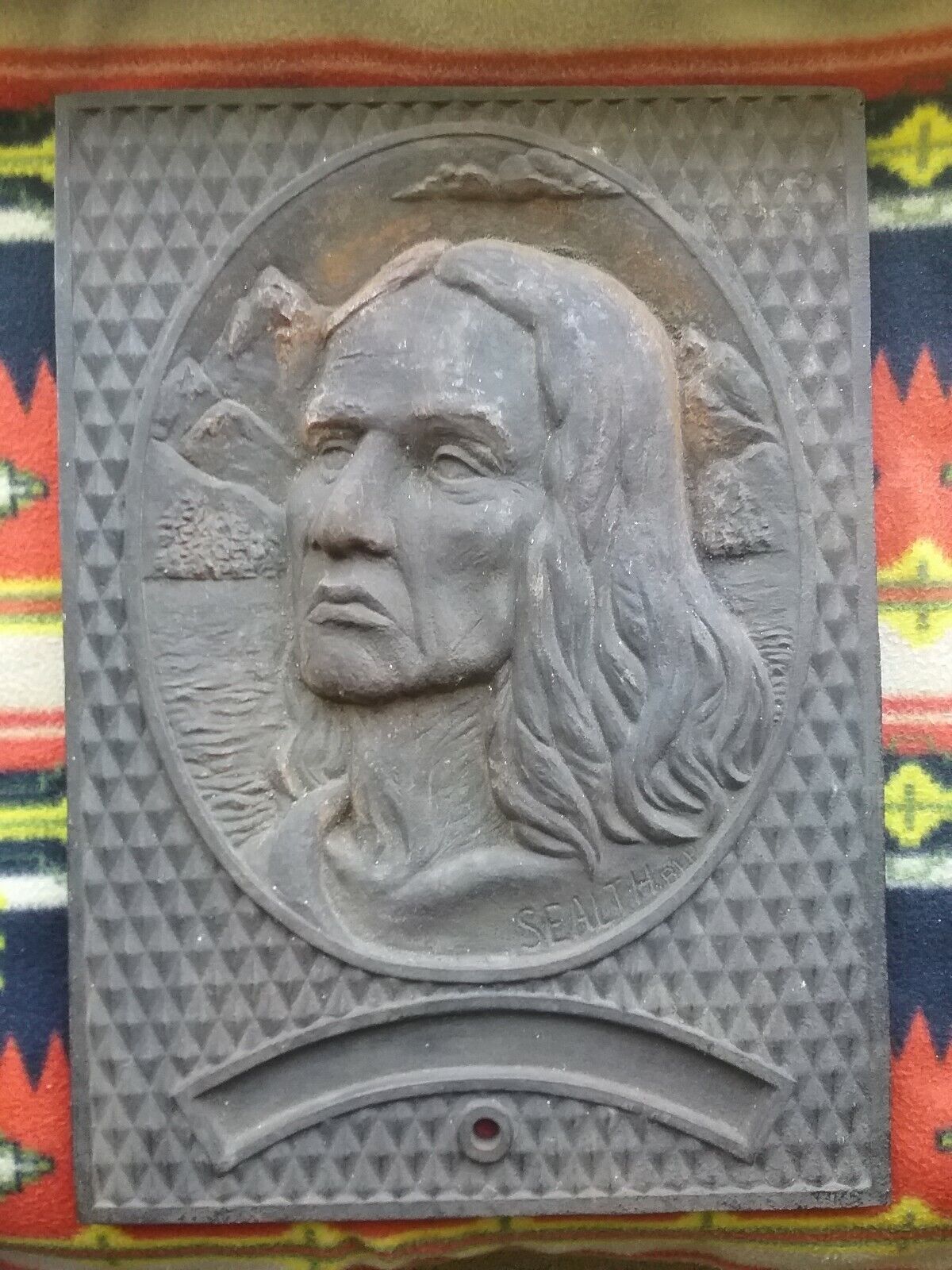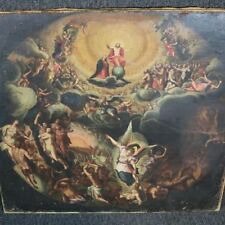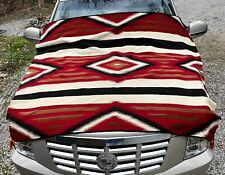Antique Chief Seattle Native American Cast Iron Memorial Pioneer Square Statue

When you click on links to various merchants on this site and make a purchase, this can result in this site earning a commission. Affiliate programs and affiliations include, but are not limited to, the eBay Partner Network.
Antique Chief Seattle Native American Cast Iron Memorial Pioneer Square Statue:
$50000.00
Antique Chief Sealth (Chief Seattle), High Relief Cast Iron Artwork found in a very old estate in the Seattle area, was perhaps used for a Sidewalk or Road Utility Cover or it may have been used as a Memorial in a park maybe Pioneer Square in Downtown Seattleor a Large Plaque from Building Salvage that may date back to the late 19th or early 20th Century...through my research I've been unable to find any other examples of this of any kind, which leads me to believe this may have been a one of a kind created for a special purpose! The Chiefs face looks very much like known photos and other sculptures that are easily found of him. It reads "SEALTH" and "RIP", it measures approx. 13" wide X 18" long X 1/2" thick around the diamond surface, andfrom the highest points front to back at about 1 1/2" thick and weighing in at about 28 lbs. with tight weathered black enamal paint, some surface rust and dirty, none of which affects the integrity of the piece. It may have been part of the Pioneer Building or thePioneer Square Pergola:ThePioneer Square Pergolais acast ironand glasspergolainPioneer Square, a park inDowntown Seattle, Washington, United States. It was built in 1909 to shelter passengers waiting forcable carson the James Street andYesler Waylines. The pergola is located at the intersection of 1st Avenue and Yesler Way, and was designated aNational Historic Landmarkin 1977 alongside the adjacentPioneer Buildingandtotem pole.[1]Pioneer Square PergolaU.S. National Register of Historic PlacesU.S. National Historic LandmarkU.S. Historic district
Contributing propertyLooking west at the pergola, 2007Location1st Avenue and Yesler Way
Seattle,Washington, F. EverettRestored1972, 2001Part ofPioneer Square–Skid Road datesAdded to NRHPMay 5, 1977DesignatedNHLMay 5, 1977DesignatedCPJune 22, 1970
The structure originally included an undergroundpublic bathroomthat was closed after the end of cable car service in the 1940s. After decades of deterioration, the pergola was restored by the city government in 1972 with an extensive renovation and dedicated as part of Pioneer Square plaza. It was rebuilt entirely in 2001 after the pergola was destroyed by asemi-truckcollision, costing $3.4 million. The rebuilt pergola has since been reinforced and protected against future collisions, but has suffered damage in other incidents.
ContentsDescription and historyEditOverhead view of the pergola, 1914TheVictorian-style, triangular structure was designed byJulian F. Everett, a local architect, and originally functioned as acomfort station. It measures 60 feet (18m) long and 16 feet (4.9m) high, supported by a series of iron columns.[2]It featured ornate iron decorations, a glass roof, and an underground public bathroom that opened on September 23, 1909, at a cost of $24,000.[1][3]The bathroom, one of the first underground facilities of its kind for Seattle, featuredterrazzofloors, brass and nickel fixtures, and white Alaskan marble stalls. It had sixteen stalls for men and nine for women, and was described as the best and most lavish public restroomwest of the Mississippi.[4]Its inclusion was controversial at the time, having been deemed an unsightly addition to the park byThe Seattle Timesand community groups.[5][6]As cable car service was cancelled and the area declined, the pergola deteriorated and was stripped for materials by the late 1940s.[7]The bathroom itself was closed in 1948 in lieu of renovations.[8]
The pergola was restored in 1972 with a $100,000 donation fromJames E. Casey, who founded theUnited Parcel Servicein Pioneer Square.[9]Using the original blueprints to recreate the ornamental roof and light fixtures,[10]restoration work began in July 1972 and was finished in February 1973 ahead of the formal dedication of the expanded Pioneer Square parkspace.[7][11][12]The pergola's underground bathroom was left untouched by the renovation and was unsuccessfully proposed as an addition to theSeattle Underground Tourin the late 1990s.[3]A similar pergola atOccidental Parkwas built in the 1970s and removed in 2006.[13][14]
The renovated pergola suffered accelerated deterioration that forced it to be closed and repaired in 1992 at a cost of $100,000, as bolts used during the restoration had rusted.[6][15]It was accidentally destroyed on January 15, 2001, in a collision with a commercialsemi-truckthat clipped the structure while making a 90-degree turn.[16][17]Owing to its status as a city landmark, the city government pledged to rebuild the pergola or build a new structure if restoration proved infeasible.[16][18]The trucking company claimed full responsibility and funded $1 million towards the cost of rebuilding the pergola through its insurer.[19]
The pergola was rebuilt by Seidelhuber Iron and Bronze Works based on repaired sections rather than the original documents, at a cost of $3.4 million.[20][21]While the project was originally planned to be finished in time for Christmas, the repair work required more time and was made more complicated by theFebruary 2001 earthquake, which caused the roof of the underground restroom to sink by 5.5 inches (14cm).[22]The Seidelhuber foundry's owners financed the project's performance bond on their own, requiring them to sell their home andwedding rings.[22]Installation of the restored pergola elements began in June 2002, using only one percent of new material for the exterior furnishings.[23]The new pergola was fitted with a steel skeleton to prevent a future collapse; the twelveCorinthian columnsand sixteen arches were rebuilt using iron from the original structure.[24]
The pergola was reopened on August 17, 2002, costing a total of $3.9 million.[25]Due to repeated vehicle strikes, the city government installed structural poles andbollardsto protect the pergola.[26]The bollards stopped two semi-trucks in 2008 and 2012 and prevented further damage to the structure.[27][28]It was struck twice in 2013 by a semi-truck and a hit-and-run driver who damaged the iron fencing around the structure.[29]Seattle Seahawksfans celebrating the team'sSuper Bowl XLVIIIvictory in February 2014 climbed atop the pergola and broke twenty of the glass roof panes;[30]Seahawks fans and private businesses later raised $25,000 throughcrowdfundingfor repairs to the structure.[31][32]In response, a temporary fence was installed around the pergola ahead of the team's appearance at thefollowing Super Bowlin 2015.[33]
Note: Pioneer Square marks Seattle's original downtown, dating back to 1852. Rebuilt after the devastating "Great Fire" of 1889, the district is characterized by late nineteenth century brick and stone buildings and one of the nation's best surviving collections of Romanesque Revival!
ThePioneer Buildingis aRichardsonian Romanesquestone, red brick,terra cotta, andcast ironbuilding located on the northeast corner of First Avenue and James Street, inSeattle'sPioneer SquareDistrict. Completed in 1892, the Pioneer Building was designed by architectElmer Fisher, who designed several of the historic district's new buildings following theGreat Seattle Fireof 1889.
Pioneer BuildingLocation within downtown SeattleRecord heightTallest inSeattleandWashington statefrom 1892 to 1904[I]Surpassed byAlaska BuildingGeneral informationTypeCommercial officesLocation600 First AvenuePioneer Square,Seattle, CoworkingManagementNovel CoworkingHeightRoof28.04m (92.0ft)Technical detailsFloor count6Design and constructionArchitectElmer H. FisherJames WehnPioneer Building, Pergola, and Totem PoleU.S. National Register of Historic PlacesU.S. National Historic LandmarkU.S. Historic district
Contributing propertyArchitecturalstyleRomanesque Revival:Richardsonian RomanesquePart ofPioneer Square–Skid Road datesAdded to NRHPMay 5, 1977DesignatedNHLMay 5, 1977DesignatedCPJune 22, 1970References[1][2][3][4]ContentsLocationEdit
From Seattle's earliest days until the early 1880s, the corner of First and James was the site ofHenry and Sarah Yesler's home and orchard, with his steam-poweredsawmilllocated across the way. His home served as the center of social life and hospitality in early Seattle. As the city's business district began to grow rapidly in the early 1880s, Yesler moved to his new mansion, designed by architectWilliam E. Boone, three blocks away at 4th and James in 1884. Rather than demolishing his old house and fully redeveloping his property, he moved the house to the back of the lot and filled his First Avenue frontage with displaced buildings purchased and relocated from across the street.
He began planning an office block at First and James in late 1888 with the completed elevation drawings by architects Fisher & Clark put on public display that December. Local media proclaimed it would be one of the finest buildings in the country, and the largest north ofSan Francisco.[5]
While the lumber was being cut and contracts for the steel work and terra cotta were still being secured, excavation for the southern half of the building began in mid-February, 1889 with the temporary relocation of several existing structures on the site, followed by their demolition, including the original Yesler home, the following month.[6]Yesler's plan was to construct the southern half of the building first, then finish the northern portion the following building season after payments for recently sold property would be secured.[7]Grading was completed and construction began in May but was soon halted due to a shortage of rough stone that was plaguing the city; only 144 tons of the 800 tons of stone that were ordered for the building could be delivered.[8]Several months after the Great Seattle Fire leveled 32 blocks of downtown and new grades and street widths had been firmly established, Yesler proceeded with the construction of the Pioneer Building.
DesignEditLearn moreThis sectiondoes notciteanysources.(February 2019)The Pioneer Building is a 94-foot-tall (29m) symmetrical block, measuring 115 by 111ft (35 by 34m).[9]The exterior walls are constructed of Bellingham Bay graysandstoneat the basement and first floor, with red brick on the upper five floors (with the exception of two stone pilasters which extended to the full height of the tower over the main entrance). Spandrel panels and other ornamental elements areterra cottafromGladding, McBeanin California. There are three projecting bays ofcast iron, the curved bays at the corner and on the James Street facade, and the angled bay above the main entrance.
The building reflects a mix of Victorian and Romanesque Revival[10]influences. The facades, with vertical pilasters and horizontal belt courses creating a grid, reflect Victorian compositional strategies. Details such as the round arches over groups of windows and the arched main entrance and corner entrance are Romanesque Revival elements.
The exterior walls are load-bearing, as is the firewall that extends through the building from the street to the alley. The interior structure iscast ironcolumns and steel beams supporting timber joists. As was typical practice in the period, the office floors were designed and built with permanent partitions forming 185 office rooms—a tenant would simply rent one or more office rooms. Light is provided to the interior through two atria—one in the center of the south portion of the building, the other in the north portion of the building.
Constructed at a cost of $270,000,[11]the Pioneer Building was considered one of Seattle's finest post-fire business blocks. It has always been highly visible, forming a portion of one side of Seattle's Pioneer Place Park.
The Pioneer Building originally had a seventh floor tower room (with a pyramidal roof) located directly above the front entrance making the building 110ft (34m). It was removed as a result of damage caused by the1949 earthquake.
HistoryEditThe newly constructed building quickly became an important business location for downtown Seattle. During theKlondike Gold Rushin 1897, there were 48 different mining companies that had offices in it. DuringProhibition, the Pioneer Building was the clandestine location of "Seattle's FirstSpeakeasy."[citation needed]
The downtown area began to grow northward, prompting businesses to move in the same direction. By the 1950s and '60s, the entire Pioneer Square district had fallen upon hard times. Many of the buildings, which were barely 60 years old, sat empty and decaying, and were slated to be torn down and replaced with parking garages. TheSeattle Hotelwas the first to be razed, which prompted the citizens to initiate a campaign to preserve the district. The rest of the buildings were spared the wrecking ball, andPioneer Square–Skid Road Historic Districtwere listed on theNational Register of Historic Places.[3]
In 1971, theNational Park Serviceproposed a purchase of the Pioneer Building to house the Seattle unit of theKlondike Gold Rush National Historical Park. The deal fell through as it was instead purchased by private entrepreneurs and eventually underwent renovations.[12]In 1977, the Pioneer Building was listed as aNational Historic Landmarkalongside two other elements of the city's post-fire rebuilding: apergolathat was built as acable carwaiting area in 1909 (Pioneer Square pergola), and the 1940 replica of a stolenTlingittotem polegifted to the city in 1899 (Pioneer Square totem pole).[4][13]
Today, the Pioneer Building houses, among other things,Doc Maynard's Nightclub and Lounge, where one can buy tickets for the popularSeattle Underground Tour. At the end of the tour, there is a gift shop, located fittingly in the building's ground-floor level.
Several businesses and offices are also located inside, including The Olmsted Law Group PLLC, dePonce Immigration and Citizenship Law, Cost of Wisconsin miniature golf-course designers' Western Regional Office, and Henry's Bail Bonds.
Current useEditIn December 2015, the Pioneer Building was purchased by workspace providerNovel Coworking, which has renovated the building's interior to create private offices and co-working space for small businesses.[14]
Being sold in as is, wonderful, used, antique condition, that should perhaps be in a museum or displayed in a Gallery!
This could be a quite valuable piece of history if its discovered where it came from...
And I'm open to offers...don't be shy!
I would like this to stay in the Seattle or Northwest area but its up for grabs...shipping is free for the USA lower 48.
Antique Chief Seattle Native American Cast Iron Memorial Pioneer Square Statue:
$50000.00

Related Items:
Antique Chief Seattle Native American Cast Iron Memorial Pioneer Square Statue
$50000.00
ANTIQUE OLD MASTER OIL PAINTING RESURRECTION JESUS FEDERICO BAROCCI BIBLE 17TH C
$29999.00
Fine Antique Authentic Navajo Dine 3rd Phase Variant Chiefs Blanket Rug Textile
$29500.00







